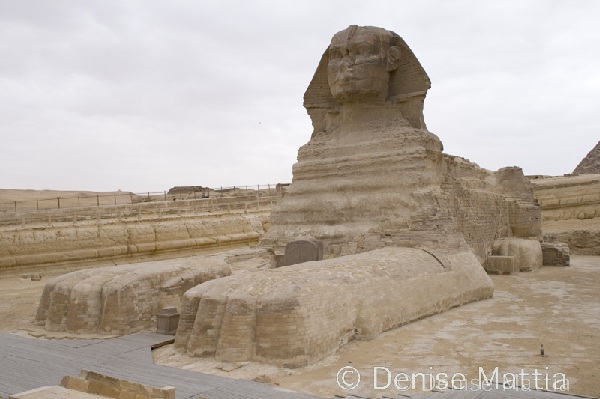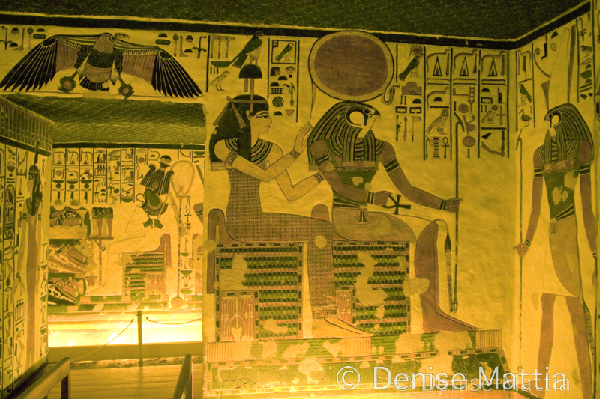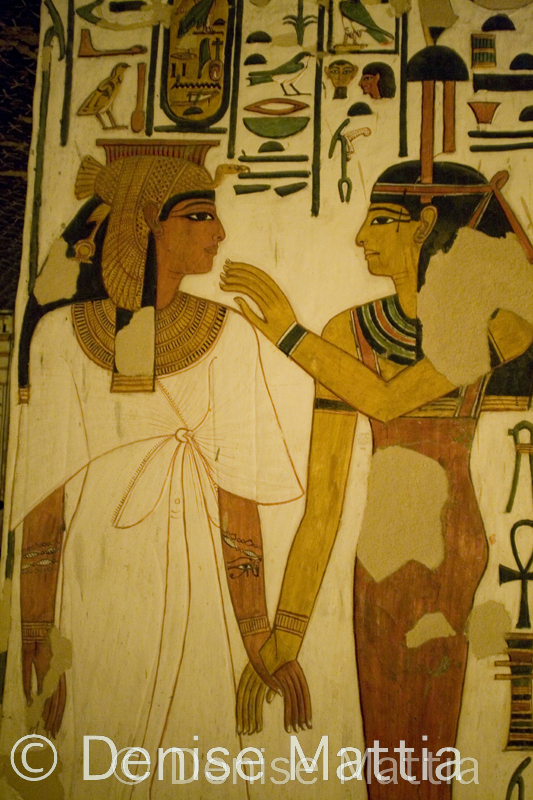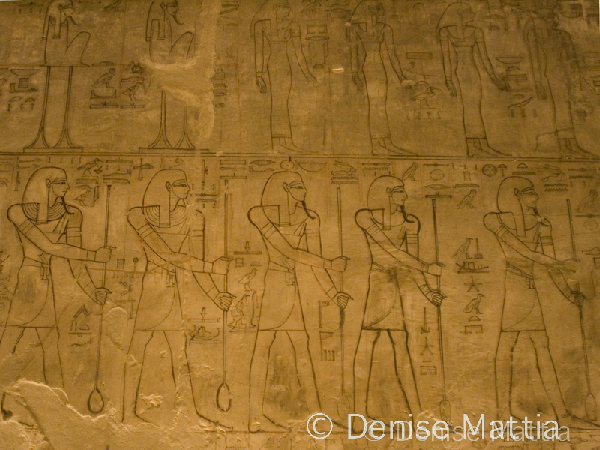By Denise Mattia
Author’s note: Although Cairo made headline news previously, visitors will find the city safer than many in the U.S. or, in fact, throughout Europe and the Middle East.
Through classical Antiquity and early Christianity visitors will find their origins in an Egyptian city where the arts, religion and government of any modern civilization developed.
More than 5,000 years ago Egypt was comprised of a group of autonomous city-states, the primary ones being Heliopolis; Memphis, the capital; Saqqara and Giza (Lower Egypt), the area of modern-day Cairo.
Thought to be the “mound of creation” Heliopolis was the center of astronomy and theology. Cosmic gods personified heaven and earth, sun and moon, air, water and desert. Rather than a single deity, the cosmic gods were divided into categories of gods in human, animal, plant and fetish forms, and became a significant part of Egyptian life, lasting 3,000 years. The scarab beetle became Atum, Khepri the winged-solar disk, Ra or Horus, the falcon-headed man wearing the pschent became the midday sun or the sun on the horizon.
After the unification of Upper and Lower Egypt by Menes and its subsequent dissolution, Heliopolis was almost completely destroyed by Persian invasions in 525 BCE. Save an obelisk and a few granite blocks, the city lies buried beneath today’s capital.
Nearing the end of the 3rd century, Alexander the Great commissioned Fort Babylon to be constructed. Located in the southern district of Cairo known today as Old Cairo, the fort is the oldest structure and the nucleus of the Coptic (Eastern) Orthodox community. Here, in addition to the Coptic Museum, are the Hanging Church, the Greek Orthodox Church of St. George, the Ben Ezra Synagogue and the Mosque of Amt Ibn al-As.
Although restored in the 18th century, the Hanging Church a.k.a. the Virgin Mary’s Coptic Orthodox Church is one of the oldest churches in Egypt. The simple halls defined by massive exterior walls are similar to Egyptian temple constructions and reflect the desert monasticism from which much of Coptic culture originated. Some copies of the paintings in the church are reminiscent of Early Christian and Byzantine works.
Of particular note among the 16,000 splendid artifacts carved in metal, stone, ivory, pottery and wood in the Coptic Museum are the frescos, which are set in strongly drawn outlines, 13th century manuscripts and a gilded bible casket from the Church of the Virgin Mary. The Museum links Pharonic, Greco-Roman and Islamic themes.
The most interesting section of the Greek Orthodox Church of St. George is the chapel, where nuns offer a collar and chain to pious worshipers who are said to be in a state of exceptional grace when they kiss the collar and pray to St. George.
Originally a Coptic church, the Ben Ezra Synagogue was purchased by Abraham Ben Ezra in 882 in payment for back-taxes imposed by Muslim rulers. The synagogue is a place of worship and pilgrimage and a site of major festival celebrations. The Basilica-style building is essentially a two-storey rectangular structure, which is subdivided into a central area. In the center is the dais for reading the Torah. A guide is on hand to tell visitors about the building and its reconstruction in 1892, where the hiding place for sacred books and Torah scrolls were discovered.
Originally built in the 7th century from palm tree trunks, mud brinks and wood, little remains today of the Mosque of Amr ibn al-As. Still, its design mirrors the aesthetic expansion and renovations by caliphs throughout the centuries. An active mosque today, visitors are welcome to view the courtyard and interior.
Outside the Coptic quarter is the Khan el-Khalili mausoleum. The tombs of the 10th century caliphs became a center of economic activity in the early 14th century. Today, amid the buzz and bustle of the touristy bazaar, visitors and locals alike purchase food, juice, souvenirs, scarves, beads, jewelry and antiques. Not to be missed is the traditional café, El Fishawy, which for two centuries has been a gathering point for Egyptian writers, poets, artists, musicians, students and intellectuals. Men and women sit in the authentic cafe drinking fresh mint tea and national favorites or smoking hookahs, the Arab water pipes called shishas.
Under Egyptian administration the Egyptian Museum continues to be the greatest repository of Egypt’s national treasures and houses objects from every facet of ancient life. Included are the diorite statue of Cephren from Giza and the gray schist statue of Thutmose III. The museum also contains massive sarcophagae and the most extreme works of the colossi of Ikhnaton from Karnak, as well as the complete, extraordinary contents of the tomb of Tutankhamen. Thousands of artifacts and statues not only in storage in the Museum but also throughout Egypt will be on display when the Grand Egyptian Museum is completed, the soft opening of which is projected for 2018.
At a commanding height that dominates the Cairo skyline, the Citadel and Mosque of Muhammad Ali is one of the most popular sites in Cairo. The 10th century Citadel provided fortification to dominate the local populace and to serve as a refuge for them in case of enemy attack. It boasts one of the world’s great works of military architecture. Most notable are the two minarets of the Mosque of Muhammad Ali. Inside the domed building, two minbars (pulpits) are carved elaborately in alabaster and in wood. These dual features were purposeful departures from Turkish design. The Mosque of Muhammad Ali, the Mosques of Sultan al-Nasir Muhammad and Sulayman Pasha, the Gawhara Palace and several museums were acquired in the late 1980s by the Supreme Council of Antiquities and are open to the public.
It’s a short drive from Cairo to Memphis, where the alabaster sphinx likely stood originally at the entrance to the temple of Ptah, the “king of Egypt.”
Situated around Memphis are animal forms, which flourished exuberantly in the Late Period (about a millennium BCE). The bull, known by the name of the fertility god, Apis, was worshiped as sacred. Links with the sun-god are found with the Apis-bull wearing the sun-disk between his horns and a winged sun-disk and the sky-vulture on his back.
The sky-goddess Sekhmet was depicted as a lioness and wore the sun-disk on her head, while her son, Nefertem was a manifestation of the morning sun. Not only did the sky-goddess give birth to the sun and stars, but she took her children back, incorporating them into her own body. Eternal life arises from the continuous cycle of birth, death, rejuvenation in the womb and rebirth, a concept familiar to Western civilization. The ruins at Memphis convey the fact that it was once the religious center of an important, extensive city.
Continuing farther up the Nile to Giza visitors stand in awe at the towering step Pyramid of Sakkara and the pyramids of Cheops, Mycerinus and Chephren. They are eternal reminders that the rulers buried beneath them have begun their voyage from the tombs to heaven, like their heavenly prototype, the sun.
A short distance from Cephren, the colossal Great Sphinx – the enigmatic combination of lion and king – crouches like a guardian of the necropolis. The Egyptians of the New Kingdom called this colossus “Horus on the Horizon,” the rising sun-god, the symbol of resurrection and the reawakening to life.
Whether Greek, Roman, Semite, Christian or Muslim, the houses of birth, death and worship lie side by side in Cairo, and are reminders that Egypt, Antiquity and the West are linked together by a common bond.
# # #
The above covered article was featured in the November/December issue of Destinations by Jax Fax.
About Denise Mattia
A writer and photographer, Denise Mattia’s works are published nationally and internationally and include all aspects of leisure travel: art , culture, resorts, spas, food and wine and sports’ activities. She's the founder of the soon to be launched Yum-Yum-Traveler, a site devoted to reviewing restaurants in addition to her travel articles from around the world. She lives and works in Manhattan, where she was born.
- Web |
- More Posts (91)






